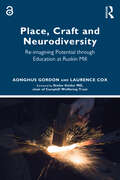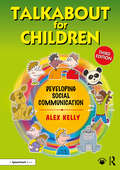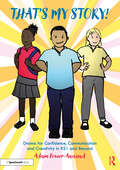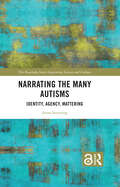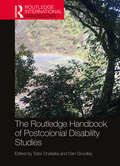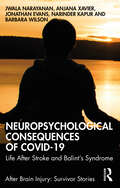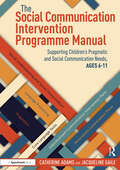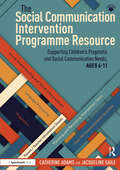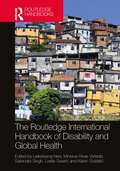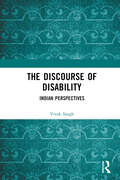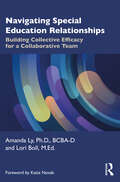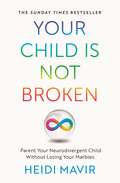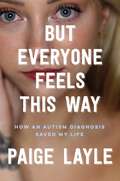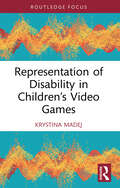- Table View
- List View
Place, Craft and Neurodiversity: Re-imagining Potential through Education at Ruskin Mill
by Aonghus Gordon Laurence CoxFor over four decades, Ruskin Mill Trust has worked with young people with special educational needs and behavioural issues who learn traditional crafts and organic farming as part of an integrated curriculum of therapeutic education, overcoming barriers to learning and re-engaging with the wider world. This accessible and inspiring book showcases how an appreciation of place, traditional crafts, farming and transformative education offers a wider route to human well-being for all. The authors outline the different fields of the “Practical Skills Therapeutic Education” method, which includes developing practical skills, learning the ecology of the farm and understanding therapeutic education, holistic care, health and self-leadership. Taking the reader on a tour of Ruskin Mill’s many extraordinary provisions across Britain, and going deeper in conversation with its founder, Aonghus Gordon, this book is an outstanding story of creative thinking in an age of narrow focus on classrooms and written examinations, presenting a transformative perspective on education and care. Being grounded in work supporting young people with complex additional needs, it provides a rare insight into the work of one of the world’s leading charities working with neurodiversity. With its non-specialist language, Place, Craft and Neurodiversity offers ideas and resources for work in different areas of education and therapy. It will inspire parents, educators and care workers around the globe.
Talkabout for Children 2: Developing Social Communication (Talkabout)
by Alex KellyTalkabout for Children: Developing Social Communication, 3rd edition is a bestselling professional workbook, designed to support educators and therapists who deliver social and relationship skills groups for children.Social communication is an essential aspect of our quality of life and this resource helps to develop this in young children aged 4-11 years old. The book introduces the second level of the Talkabout hierarchy and provides three sections full of practical activities exploring the areas of Talkabout Body Language, Talkabout Conversations, and Talkabout Assertiveness. Resources include: Planning and evaluation forms A three-term intervention plan for schools Over 60 structured activity sessions focusing on social communication Ideas for group cohesion activities to use at the beginning and end of sessions All the supplementary handouts and images needed to deliver the session, with resources available to photocopy or download and print. Fully updated and revised, this third edition is presented with full-colour illustrations and handouts and includes a new introduction by Alex Kelly reflecting on her own experiences of using the resources since they were first developed. This key resource will help teachers, teaching assistants, health care professionals and parents to support children’s social communication.
That's My Story!: Drama for Confidence, Communication and Creativity in KS1 and Beyond
by Adam Power-AnnandThe ability to communicate is an essential life skill for all children and young people and it underpins their social, emotional and educational development. If a child experiences a positive relationship with an adult listening carefully, they are more likely to constructively share their thoughts, feelings and their imaginative ideas.That’s My Story! places children’s imagined stories at the heart of their own development and provides a joyful, creative approach to support young children’s personal and social development and to encourage their communication. In this book you will find: Tried-and-tested drama games and activities that support communication and well-being, all adaptable to complement your current practice Guidance and advice on how to promote positive adult-child interactions Examples of creative interventions that support children’s communication development A celebration of the joy that comes with carefully listening to children’s own imagined stories Those of us who work with children can sense a tangible connection between how young children feel and how they communicate. This essential and practical resource will be valuable reading for primary teachers, teaching assistants, speech and language therapists, and drama practitioners, as well as outreach and education departments of theatre companies and other arts organisations.
That's My Story!: Drama for Confidence, Communication and Creativity in KS1 and Beyond
by Adam Power-AnnandThe ability to communicate is an essential life skill for all children and young people and it underpins their social, emotional and educational development. If a child experiences a positive relationship with an adult listening carefully, they are more likely to constructively share their thoughts, feelings and their imaginative ideas.That’s My Story! places children’s imagined stories at the heart of their own development and provides a joyful, creative approach to support young children’s personal and social development and to encourage their communication. In this book you will find: Tried-and-tested drama games and activities that support communication and well-being, all adaptable to complement your current practice Guidance and advice on how to promote positive adult-child interactions Examples of creative interventions that support children’s communication development A celebration of the joy that comes with carefully listening to children’s own imagined stories Those of us who work with children can sense a tangible connection between how young children feel and how they communicate. This essential and practical resource will be valuable reading for primary teachers, teaching assistants, speech and language therapists, and drama practitioners, as well as outreach and education departments of theatre companies and other arts organisations.
Narrating the Many Autisms: Identity, Agency, Mattering
by Anna StenningAutism is a profoundly contested idea. The focus of this book is not what autism is or what autistic people are, but rather, it grapples with the central question: what does it take for autistic people to participate in a shared world as equals with other people? Drawing from her close reading of a range of texts, by autistic authors, filmmakers, bloggers, and academics, Anna Stenning highlights the creativity and imagination in these accounts and also considers the possibilities that emerge when the unexpected and novel aspects of experience are attended to and afforded their due space. Approaching these narrative accounts in the context of both the Anthropocene and neoliberalism Stenning unpacks and reframes understandings about autism and identity, agency and mattering, across sections exploring autistic intelligibility, autistic sensibility, and community-oriented collaboration and care. By moving away from the non-autistic stories about autism that have, over time, dominated public conception of the autistic experience and relationships, as well as the cognitive and psychoanalytic paradigms that have reduced autism and autistic people to a homogeneous group, the book instead reveals the multiplicity of autistic subjectivities and their subsequent understandings of oppression. It calls on readers to listen to what autistic people have to say about the possibilities of resistance and solidarity against intersecting currents and eddies of power, which endanger all who challenge the neoliberal conception of Life. A stirring and meaningful departure from atomized accounts of neurological difference, Narrating the Many Autisms ponders big questions about its topic and finds clarity and meaning in the sense-making practices of autistic individuals and groups. It will appeal to scholarly readers across the fields of disability studies, cultural studies, critical psychology, sociology, anthropology, and literature. The Open Access version of this book, available at http://www.taylorfrancis.com, has been made available under a Creative Commons [Attribution-Non Commercial-No Derivatives (CC-BY-NC-ND)] 4.0 license.
Narrating the Many Autisms: Identity, Agency, Mattering
by Anna StenningAutism is a profoundly contested idea. The focus of this book is not what autism is or what autistic people are, but rather, it grapples with the central question: what does it take for autistic people to participate in a shared world as equals with other people? Drawing from her close reading of a range of texts, by autistic authors, filmmakers, bloggers, and academics, Anna Stenning highlights the creativity and imagination in these accounts and also considers the possibilities that emerge when the unexpected and novel aspects of experience are attended to and afforded their due space. Approaching these narrative accounts in the context of both the Anthropocene and neoliberalism Stenning unpacks and reframes understandings about autism and identity, agency and mattering, across sections exploring autistic intelligibility, autistic sensibility, and community-oriented collaboration and care. By moving away from the non-autistic stories about autism that have, over time, dominated public conception of the autistic experience and relationships, as well as the cognitive and psychoanalytic paradigms that have reduced autism and autistic people to a homogeneous group, the book instead reveals the multiplicity of autistic subjectivities and their subsequent understandings of oppression. It calls on readers to listen to what autistic people have to say about the possibilities of resistance and solidarity against intersecting currents and eddies of power, which endanger all who challenge the neoliberal conception of Life. A stirring and meaningful departure from atomized accounts of neurological difference, Narrating the Many Autisms ponders big questions about its topic and finds clarity and meaning in the sense-making practices of autistic individuals and groups. It will appeal to scholarly readers across the fields of disability studies, cultural studies, critical psychology, sociology, anthropology, and literature. The Open Access version of this book, available at http://www.taylorfrancis.com, has been made available under a Creative Commons [Attribution-Non Commercial-No Derivatives (CC-BY-NC-ND)] 4.0 license.
The Routledge Handbook of Postcolonial Disability Studies (Routledge International Handbooks)
This book centres and explores postcolonial theory, which looks at issues of power, economics, politics, religion and culture and how these elements work in relation to colonial supremacy. It argues that disability is a constitutive material presence in many postcolonial societies and that progressive disability politics arise from postcolonial concerns. By drawing these two subjects together, this handbook challenges oppression, voicelessness, stereotyping, undermining, neo-colonisation and postcolonisation and bridges binary debate between global North and the global South.The book is divided into eight sectionsi Setting the Sceneii Decolonising Disability Studiesiii Postcolonial Theory, Inclusive Developmentiv Postcolonial Disability Studies and Disability Activismv Postcolonial Disability and Childhood Studiesvi Postcolonial Disability Studies and Educationvii Postcolonial Disability Studies, Gender, Race and Religionviii ConclusionAnd comprised of 27 newly written chapters, this book leads with postcolonial perspectives – closely followed by an engagement with critical disability studies – with the explicit aim of foregrounding these contributions; pulling them in from the edges of empirical and theoretical work where they often reside in mainstream academic literature.The book will be of interest to all scholars and students of disability studies and postcolonial studies as well as those working in sociology, literature and development studies.
The Routledge Handbook of Postcolonial Disability Studies (Routledge International Handbooks)
by Tsitsi Chataika Dan GoodleyThis book centres and explores postcolonial theory, which looks at issues of power, economics, politics, religion and culture and how these elements work in relation to colonial supremacy. It argues that disability is a constitutive material presence in many postcolonial societies and that progressive disability politics arise from postcolonial concerns. By drawing these two subjects together, this handbook challenges oppression, voicelessness, stereotyping, undermining, neo-colonisation and postcolonisation and bridges binary debate between global North and the global South.The book is divided into eight sectionsi Setting the Sceneii Decolonising Disability Studiesiii Postcolonial Theory, Inclusive Developmentiv Postcolonial Disability Studies and Disability Activismv Postcolonial Disability and Childhood Studiesvi Postcolonial Disability Studies and Educationvii Postcolonial Disability Studies, Gender, Race and Religionviii ConclusionAnd comprised of 27 newly written chapters, this book leads with postcolonial perspectives – closely followed by an engagement with critical disability studies – with the explicit aim of foregrounding these contributions; pulling them in from the edges of empirical and theoretical work where they often reside in mainstream academic literature.The book will be of interest to all scholars and students of disability studies and postcolonial studies as well as those working in sociology, literature and development studies.
Neuropsychological Consequences of COVID-19: Life After Stroke and Balint's Syndrome (ISSN)
by Jwala Narayanan Anjana Xavier Jonathan Evans Narinder Kapur Barbara WilsonNeuropsychological Consequences of COVID-19 focuses on Anjana’s journey as a COVID survivor following a brain injury that left her with a very rare neuropsychological syndrome called Balint’s syndrome, a disorder associated with difficulties in visual and spatial coordination. It is also the first book of its kind to provide a first-hand account from India on surviving brain injury, from diagnosis, recovery and rehabilitation, providing the therapeutic milieu in the Indian context and exploring cultural influences on rehabilitation.Written jointly by Anjana, her neuropsychologist and the international experts in the field of neuropsychology who were also involved in her diagnosis and care, the book highlights how COVID-19, a virus primarily affecting the respiratory system, can also result in a disabling brain injury. It describes Anjana’s recovery and the rehabilitation she received and provides a deeper understanding of this experience of a very rare condition through the views of Anjana herself. In addition, Anjana’s rehabilitation journey stumbles upon many important themes of rehabilitation including cultural sensitivity, personal identity, resilience, role of family and rehabilitation in a low to middle income country.This book is valuable reading for clinical and neuropsychologists, neurologists, other rehabilitation therapists including physiotherapists, occupational therapists, nurses and social work professionals, particularly those interested in cross cultural rehabilitation. It will also be of interest to students in these fields.
Neuropsychological Consequences of COVID-19: Life After Stroke and Balint's Syndrome (ISSN)
by Jwala Narayanan Anjana Xavier Jonathan Evans Narinder Kapur Barbara WilsonNeuropsychological Consequences of COVID-19 focuses on Anjana’s journey as a COVID survivor following a brain injury that left her with a very rare neuropsychological syndrome called Balint’s syndrome, a disorder associated with difficulties in visual and spatial coordination. It is also the first book of its kind to provide a first-hand account from India on surviving brain injury, from diagnosis, recovery and rehabilitation, providing the therapeutic milieu in the Indian context and exploring cultural influences on rehabilitation.Written jointly by Anjana, her neuropsychologist and the international experts in the field of neuropsychology who were also involved in her diagnosis and care, the book highlights how COVID-19, a virus primarily affecting the respiratory system, can also result in a disabling brain injury. It describes Anjana’s recovery and the rehabilitation she received and provides a deeper understanding of this experience of a very rare condition through the views of Anjana herself. In addition, Anjana’s rehabilitation journey stumbles upon many important themes of rehabilitation including cultural sensitivity, personal identity, resilience, role of family and rehabilitation in a low to middle income country.This book is valuable reading for clinical and neuropsychologists, neurologists, other rehabilitation therapists including physiotherapists, occupational therapists, nurses and social work professionals, particularly those interested in cross cultural rehabilitation. It will also be of interest to students in these fields.
The Social Communication Intervention Programme Manual: Supporting Children's Pragmatic and Social Communication Needs, Ages 6-11 (The Social Communication Intervention Programme)
by Catherine Adams Jacqueline GaileThe Social Communication Intervention Programme (SCIP) has been developed to support school-aged children (6–11 years) with social communication, pragmatic, and language needs. The Social Communication Intervention Programme Manual provides a rationale and method for providing specialist level language therapy for these children who have significant social communication differences. Evidence for the effectiveness of SCIP is included in The Manual.This book introduces the SCIP model and explores the three main components: social understanding/social inference, pragmatics, and language processing. Guidance is included on how to link assessment with therapy, how to plan and individualise interventions, and how to proceed with the programme. It contains a wealth of real-life case examples to illustrate key points, with step-by-step instructions for carrying out the interventions.Used alongside The Social Communication Intervention Programme Resource, this book offers a truly practical, tried-and-tested model to provide targeted, individualised intervention for children with social communication challenges. It is an essential tool for speech and language therapists, specialist teachers, and psychologists who are working with children with social communication, pragmatic, and language needs.For the most effective use, The SCIP Manual should be purchased alongside The SCIP Resource.
The Social Communication Intervention Programme Manual: Supporting Children's Pragmatic and Social Communication Needs, Ages 6-11 (The Social Communication Intervention Programme)
by Catherine Adams Jacqueline GaileThe Social Communication Intervention Programme (SCIP) has been developed to support school-aged children (6–11 years) with social communication, pragmatic, and language needs. The Social Communication Intervention Programme Manual provides a rationale and method for providing specialist level language therapy for these children who have significant social communication differences. Evidence for the effectiveness of SCIP is included in The Manual.This book introduces the SCIP model and explores the three main components: social understanding/social inference, pragmatics, and language processing. Guidance is included on how to link assessment with therapy, how to plan and individualise interventions, and how to proceed with the programme. It contains a wealth of real-life case examples to illustrate key points, with step-by-step instructions for carrying out the interventions.Used alongside The Social Communication Intervention Programme Resource, this book offers a truly practical, tried-and-tested model to provide targeted, individualised intervention for children with social communication challenges. It is an essential tool for speech and language therapists, specialist teachers, and psychologists who are working with children with social communication, pragmatic, and language needs.For the most effective use, The SCIP Manual should be purchased alongside The SCIP Resource.
The Social Communication Intervention Programme Resource: Supporting Children's Pragmatic and Social Communication Needs, Ages 6-11 (The Social Communication Intervention Programme)
by Catherine Adams Jacqueline GaileThe Social Communication Intervention Programme (SCIP) has been developed to support school-aged children (6–11 years) with social communication, pragmatic, and language needs. SCIP provides a rationale and method for providing specialist level pragmatics and language therapy for these children who have significant social communication differences.The SCIP model is introduced in The Social Communication Intervention Programme Manual, and this book presents the content of the intervention programme itself, using a nested structure of 150 adaptable therapy activities. It contains the complete set of resources required to plan and deliver the interventions set out in the companion book, including forms, activities, and ready-made information sheets. Content can also be downloaded and printed for easy use.Used alongside The Social Communication Intervention Programme Manual, this book offers a truly practical, tried-and-tested model to provide targeted, individualised intervention for children with social communication challenges. It is an essential tool for speech and language therapists, specialist teachers, and psychologists who are working with children with social communication, pragmatic, and language needs.For the most effective use, The SCIP Resource should be purchased alongside The SCIP Manual.
The Social Communication Intervention Programme Resource: Supporting Children's Pragmatic and Social Communication Needs, Ages 6-11 (The Social Communication Intervention Programme)
by Catherine Adams Jacqueline GaileThe Social Communication Intervention Programme (SCIP) has been developed to support school-aged children (6–11 years) with social communication, pragmatic, and language needs. SCIP provides a rationale and method for providing specialist level pragmatics and language therapy for these children who have significant social communication differences.The SCIP model is introduced in The Social Communication Intervention Programme Manual, and this book presents the content of the intervention programme itself, using a nested structure of 150 adaptable therapy activities. It contains the complete set of resources required to plan and deliver the interventions set out in the companion book, including forms, activities, and ready-made information sheets. Content can also be downloaded and printed for easy use.Used alongside The Social Communication Intervention Programme Manual, this book offers a truly practical, tried-and-tested model to provide targeted, individualised intervention for children with social communication challenges. It is an essential tool for speech and language therapists, specialist teachers, and psychologists who are working with children with social communication, pragmatic, and language needs.For the most effective use, The SCIP Resource should be purchased alongside The SCIP Manual.
The Routledge International Handbook of Disability and Global Health (Routledge International Handbooks)
This handbook will raise awareness about the importance of health and well-being of people with disabilities in the context of the global development agenda: Leaving No-one Behind.There has been a growing discussion on how people with disabilities should be included in the global health landscape. An estimated one billion people have some form of disability, 80% of whom live in low- and middle-income settings. People with disabilities are more likely to be poor, with restricted access to health and social services, education, rehabilitation and employment. Despite this, people with disabilities are often overlooked in global health and development efforts. Furthermore, the COVID-19 pandemic has shown that unless systematically planned for and included in policies and programmes, people with disabilities remain at an increased risk of being adversely affected in times of humanitarian crisis and emergency disasters.Divided into eight sections: Disability and Health Frameworks Health Justice, Rights and Bioethics Gendering Disability Health Disability and Global Mental Health Disability and Access to Healthcare, Including Workforce Development Crises and Health Technology and Digital Health Disability, Ageing and Dementia Care This handbook covers the full range of topics pertaining to disability and global health including inclusive health; access to rehabilitation; global mental health and disability; medical training and disability; community based inclusive development for improving health and rehabilitation; maternal health and sexual reproduction; preventive care and health promotion for people with disabilities; health, disability and indigenous knowledges; bioethics and human rights; data protection; and health in the global south.It will be of interest to all scholars, students and professionals working in the fields of disability studies, health studies, nursing, medicine, allied health, development studies and sociology.
The Routledge International Handbook of Disability and Global Health (Routledge International Handbooks)
by Leslie Swartz Karen Soldatić Lieketseng Ned Minerva Rivas Velarde Satendra SinghThis handbook will raise awareness about the importance of health and well-being of people with disabilities in the context of the global development agenda: Leaving No-one Behind.There has been a growing discussion on how people with disabilities should be included in the global health landscape. An estimated one billion people have some form of disability, 80% of whom live in low- and middle-income settings. People with disabilities are more likely to be poor, with restricted access to health and social services, education, rehabilitation and employment. Despite this, people with disabilities are often overlooked in global health and development efforts. Furthermore, the COVID-19 pandemic has shown that unless systematically planned for and included in policies and programmes, people with disabilities remain at an increased risk of being adversely affected in times of humanitarian crisis and emergency disasters.Divided into eight sections: Disability and Health Frameworks Health Justice, Rights and Bioethics Gendering Disability Health Disability and Global Mental Health Disability and Access to Healthcare, Including Workforce Development Crises and Health Technology and Digital Health Disability, Ageing and Dementia Care This handbook covers the full range of topics pertaining to disability and global health including inclusive health; access to rehabilitation; global mental health and disability; medical training and disability; community based inclusive development for improving health and rehabilitation; maternal health and sexual reproduction; preventive care and health promotion for people with disabilities; health, disability and indigenous knowledges; bioethics and human rights; data protection; and health in the global south.It will be of interest to all scholars, students and professionals working in the fields of disability studies, health studies, nursing, medicine, allied health, development studies and sociology.
The Discourse of Disability: Indian Perspectives
by Vivek SinghThis book explores the concept of disability through a social, political, cultural, religious, and economics lens. It challenges the categorization of ‘physically-disabled’ produced by way of legal, medical, political, cultural, and literary narratives that comprise an exclusionary discourse.The volume discusses themes like disability and identity politics; disability and the western epistemology; disability in India; disability and the Indian English fiction and Hindi cinema to question the embodied hegemony of ‘norms’ and their effects in the construction and history of societies. It analyses select literary and cinematic texts like Trying to Grow, Fireproof, and Animal’s People; and movies, Black and Lafangey Parindey to critically examine the representation of disabled people as freak, monstrous and animal. The book also makes policy recommendations for inclusive education and work norms for disabled people.This book will be beneficial for scholars and researchers of disability studies, cultural studies, film studies, and English literature.
The Discourse of Disability: Indian Perspectives
by Vivek SinghThis book explores the concept of disability through a social, political, cultural, religious, and economics lens. It challenges the categorization of ‘physically-disabled’ produced by way of legal, medical, political, cultural, and literary narratives that comprise an exclusionary discourse.The volume discusses themes like disability and identity politics; disability and the western epistemology; disability in India; disability and the Indian English fiction and Hindi cinema to question the embodied hegemony of ‘norms’ and their effects in the construction and history of societies. It analyses select literary and cinematic texts like Trying to Grow, Fireproof, and Animal’s People; and movies, Black and Lafangey Parindey to critically examine the representation of disabled people as freak, monstrous and animal. The book also makes policy recommendations for inclusive education and work norms for disabled people.This book will be beneficial for scholars and researchers of disability studies, cultural studies, film studies, and English literature.
Navigating Special Education Relationships: Building Collective Efficacy for a Collaborative Team
by Amanda Ly Lori BollTold through a series of real-life stories and hard-learned lessons, Amanda Ly and Lori Boll share the challenges in special education relationships experienced through the lens of a special educator, a parent of a son with profound disabilities, and a child psychologist.Ideally, teachers, therapists, and parents working with students with special needs should form a cohesive team. However, these three parties often function as separate entities with different goals and objectives. Over the past 25 years, the authors have observed a consistent pattern of miscommunication and overlooking the importance of the mental and physical well-being of each team member, which contributed to poor collaboration. This book takes readers on a journey through the process of discovering whether you have, or are working with, a student with special needs; navigating how to best work with the student and other members of the team; and lastly, discussing ways to empower the reader and all members of the team. The authors posit that if we understand one another's perspectives, learn how to communicate more effectively, and focus on self-care, we will increase Collective Efficacy and become the collaborative team our students need us to be.As the first book to connect the concept of Collective Efficacy to special education, this is a must-read for teachers, therapists, and parents aiming to grasp the complexities of relationships in special education teams and better understand how mental health influences the effectiveness of each individual’s role.
Navigating Special Education Relationships: Building Collective Efficacy for a Collaborative Team
by Amanda Ly Lori BollTold through a series of real-life stories and hard-learned lessons, Amanda Ly and Lori Boll share the challenges in special education relationships experienced through the lens of a special educator, a parent of a son with profound disabilities, and a child psychologist.Ideally, teachers, therapists, and parents working with students with special needs should form a cohesive team. However, these three parties often function as separate entities with different goals and objectives. Over the past 25 years, the authors have observed a consistent pattern of miscommunication and overlooking the importance of the mental and physical well-being of each team member, which contributed to poor collaboration. This book takes readers on a journey through the process of discovering whether you have, or are working with, a student with special needs; navigating how to best work with the student and other members of the team; and lastly, discussing ways to empower the reader and all members of the team. The authors posit that if we understand one another's perspectives, learn how to communicate more effectively, and focus on self-care, we will increase Collective Efficacy and become the collaborative team our students need us to be.As the first book to connect the concept of Collective Efficacy to special education, this is a must-read for teachers, therapists, and parents aiming to grasp the complexities of relationships in special education teams and better understand how mental health influences the effectiveness of each individual’s role.
Your Child is Not Broken: Parent Your Neurodivergent Child Without Losing Your Marbles
by Heidi MavirNEW UPDATED EDITION of the SUNDAY TIMES BESTSELLERYour Child Is Not Broken is THE book for parents who need permission to do things differentlyAn unapologetic, deeply moving manual for parents of neurodivergent children from Heidi Mavir, a late-identified, neurodivergent adult and parent to an autistic/ADHD teenager. This updated edition includes information on Pathological Demand Avoidance, Rejection Sensitivity Dysphoria, an interview with Heidi's son Theo and more.Follow Heidi's irreverent and brutally honest story of her fight to be seen, heard and supported, while swimming against a tide of parent blame, ableist stereotypes and the weight of other people’s opinions. Your Child Is Not Broken is a call to arms for parents and carers of autistic, ADHD, or otherwise neurodivergent children. It is the book that no one has dared to write but every parent needs to read. Heidi’s hilarious anecdotes and heartbreaking storytelling offer validation, comfort, reassurance and wisdom to parents who need it the most.
Living With Hearing Loss and Deafness: A guide to owning it and loving it
by Samantha Baines'Highly informative, told with warmth and humour' - Adam Kay, author of This is Going to Hurt'Heartfelt and hilarious - deaf awareness beautifully told through Sam's unique voice' - Laura Whitmore'This book is important' - Mark Atkinson, CEO of the Royal National Institute for Deaf People'Samantha is a strong and powerful woman who talks so openly about her life and about being a part of the deaf community. To have someone who wants to help and wants to make a difference is so important and Sam is that person.' - Gaby RoslinThis is an all-you-need-to-know book about hearing loss and deafness, including facts, experiences and words of wisdom from experts at the RNID, audiologists, deaf activists and people who use and teach sign language. Having been on her own deaf journey, Samantha Baines has met wonderful, interesting, courageous people of all ages who also happen to be deaf. In this book, alongside the experts, she weaves together their insights and advice and, importantly, teaches those of us who aren't deaf, what it is like for those who are. Along the way, she looks at:* The first signs of hearing loss* What is tinnitus?* What to expect at a hearing test* Will I lose my job?* Am I disabled?* What are hearing aids and why do you need them?* Deaf dating* Lipreading* What is sign language?* What not to say to someone with hearing loss* And much more...'This is the book I wish I could have bought when the audiologist told me I needed a hearing aid, and I hope it can help you understand this new world you are stepping into. Welcome to the deaf club.' Samantha Baines
But Everyone Feels This Way: How an Autism Diagnosis Saved My Life
by Paige LayleIn But Everyone Feels This Way, Autism acceptance activist and multi-million-follower TikTok influencer Paige Layle shares her deeply personal journey to diagnosis and living life autistically. It all started out pretty normal: Paige lived in the countryside with her parents and brother Graham. She went to school, hung out with friends, and all the while everything seemed so much harder than it needed to be. A break in routine threw off the whole day. If her teacher couldn't answer 'why?' in class, she dissolved into tears, unable to articulate her own confusion or explain her lack of control. But Paige was normal. She smiled in photos, picked her feet up when her mum needed to vacuum instead of fleeing the room, and did well at school. She was popular and well-liked. And until she had a full mental breakdown, no one believed her when she claimed that she was not okay.Women are frequently diagnosed with autism much later than men, often in their late teens or early twenties. Armed with her new diagnosis, Paige set out to learn how to live her authentic, autistic life, and discovered how autism could be a source of strength. She challenges stigmas, taboos, and stereotypes so that everyone can see themselves authentically. Along the way, her online activism has spread awareness, acceptance, and self-recognition in millions of others.
Representation of Disability in Children’s Video Games (Routledge Research in Disability and Media Studies)
by Krystina MadejRepresentation of Disability in Children’s Video Games looks at how children’s engagement with characters and stories in video games helps create the perception of disability they have as teens and adults. Drawing on child development theory supported by neuroscience, the book shows how the scaffold of information, the schema, adults have of disability is first created at a very young age as they interact through game play with characters with disabilities. Positing that early video game play experiences should provide exposure to narrative schemas that add understanding and help create meaning about the disability represented, the book presents how such representation in children’s video games maps against cognitive development, and the psychomotor and cognitive needs and abilities of children ages 3 to 12. Close reading of over 40 PEGI 3 and PEGI 7 (ESRB E, 10+) games and analysis of games as diverse as Backyard Baseball and Sly Cooper helped define broad categories of representation: representation can be cosmetic, providing exposure but not gameplay utility; it can be incidental, used as a device that provides purpose for the narrative; or it can more authentically represent the disability as integral to the character and their life. The book provides readers with an overview of contemporary games that betters their understanding of how children’s games present disability and how children create their perceptions through interaction with characters and stories. This book will be of interest to academics and students of game studies, in particular topics such as behavioural science, ethics, and HCI, as well as sociology, communications, and digital media.
Representation of Disability in Children’s Video Games (Routledge Research in Disability and Media Studies)
by Krystina MadejRepresentation of Disability in Children’s Video Games looks at how children’s engagement with characters and stories in video games helps create the perception of disability they have as teens and adults. Drawing on child development theory supported by neuroscience, the book shows how the scaffold of information, the schema, adults have of disability is first created at a very young age as they interact through game play with characters with disabilities. Positing that early video game play experiences should provide exposure to narrative schemas that add understanding and help create meaning about the disability represented, the book presents how such representation in children’s video games maps against cognitive development, and the psychomotor and cognitive needs and abilities of children ages 3 to 12. Close reading of over 40 PEGI 3 and PEGI 7 (ESRB E, 10+) games and analysis of games as diverse as Backyard Baseball and Sly Cooper helped define broad categories of representation: representation can be cosmetic, providing exposure but not gameplay utility; it can be incidental, used as a device that provides purpose for the narrative; or it can more authentically represent the disability as integral to the character and their life. The book provides readers with an overview of contemporary games that betters their understanding of how children’s games present disability and how children create their perceptions through interaction with characters and stories. This book will be of interest to academics and students of game studies, in particular topics such as behavioural science, ethics, and HCI, as well as sociology, communications, and digital media.
